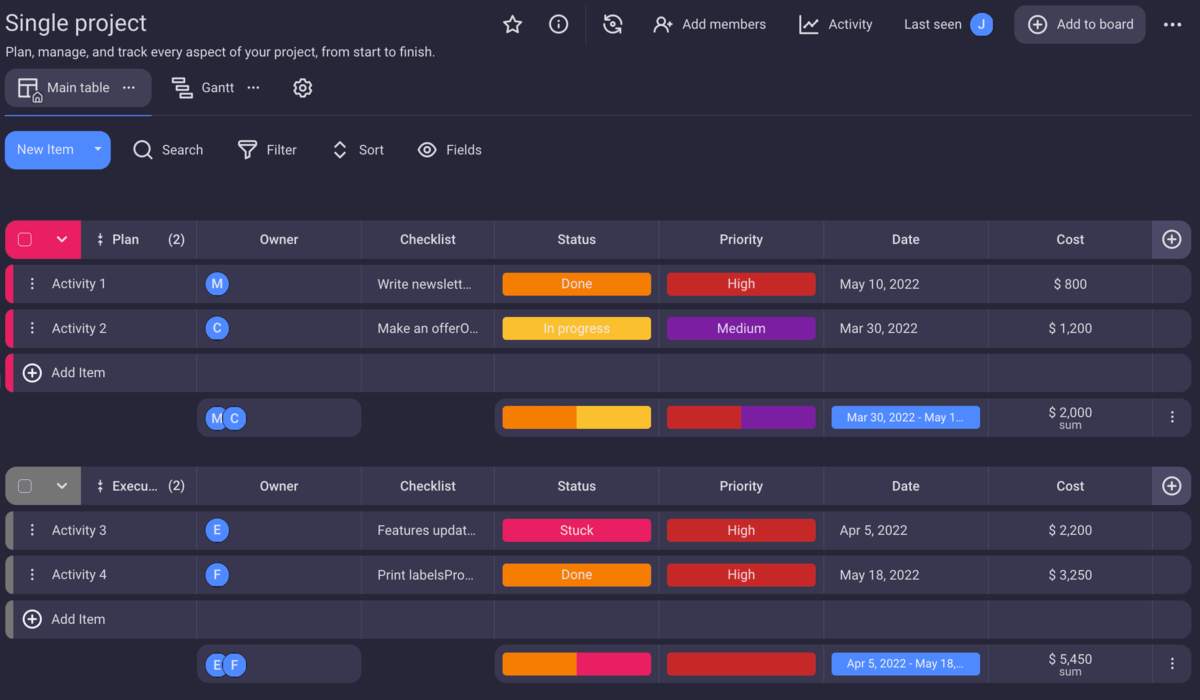What Is a Project Analyst?
A project is an intricate web of tasks, goals, deadlines, budget cuts, and emerging problems. This is often too much for one person to oversee without any assistance — meaning a project manager cannot handle all of this on their own.
So, how do they make sure that all aspects of the project can run smoothly?
The answer is simple — employ a project analyst.
The role of a project analyst may not be familiar to everyone. The aim of this article is to shed light on:
- What a project analyst is,
- What a project analyst does,
- Project analyst qualifications,
- Project analyst skills, and
- Project analyst salary and job opportunities.
After reading this article, you will have a better understanding of the project analyst’s role in project management and decide if this might be a job you want to pursue in the future.

Table of Contents
Project analyst definition
A project analyst is an important role in project management.
They are the project manager’s closest associate and the person they rely on to make sure everything is under control and functioning as it should. The project analyst analyzes data, makes reports, keeps track of the project’s progress, and supports the team in their work.
This allows the project manager to focus on the bigger picture, while the analyst gets into details — the nitty-gritty of the project.
Hierarchically, it is a mid-level position, between the project manager and the rest of the team.
Project analyst vs. project manager
Before we compare a project analyst with a project manager, let us take a look at what PMBOK — 6th edition says about project managers:
“The project manager is not expected to perform every role on the project, but should possess project management knowledge, technical knowledge, understanding, and experience. The project manager provides the project team with leadership, planning, and coordination through communications.”
So, a project manager oversees the project as a whole, but since a project has many parts, they cannot manage every single aspect of it. They make the most important decisions and rely on project analysts to provide them with the information they need to make those decisions.
People working as project analysts are often later promoted to the position of project manager.
Sometimes, a person can perform the roles of both the project manager and the project analyst. For example, in the case of a project with a small scope and a small team working on it, one person can handle both positions.
However, larger and more complex projects usually require two separate professionals for the roles.
💡 Plaky Pro Tip
If you want to learn more about project managers’ responsibilities, check out the link below:
Project analyst vs. business analyst
To understand the difference between these two roles, we should first see what a business analyst does. According to Forbes:
“A business analyst commonly reviews and analyzes key business metrics to devise plans for improvement, then communicates these findings and plans to key stakeholders in the business.”
Both the project and business analyst are in charge of analyzing data that helps people in the company make informed decisions.
However, the difference is that a business analyst focuses on the entire business, whereas a project analyst’s job is centered around a project.
A company will usually employ both the project analyst and the business analyst, and they often collaborate with each other.
What does a project analyst do?
Project analysts have a diverse range of tasks and responsibilities. The main duties of a project analyst include:
- Gathering and analyzing data relevant to the project,
- Developing project strategies,
- Writing documentation,
- Supporting the team members and the project manager, and
- Communicating with stakeholders.
Gathering and analyzing data relevant to the project
As the name suggests, the most important duty of a project analyst is connected to analyzing data relevant to the project.
They collect diverse data through various processes such as getting feedback from the team members, monitoring project’s key performance indicators (KPIs), following market trends, keeping track of legislations, and more.
This data is then analyzed, documented, and presented to the stakeholders — primarily to the project manager to help them make decisions and manage the project efficiently.
Developing project strategies
One of the project analyst’s tasks is to create an elaborate strategy for the project to help the project stay on schedule and achieve its goals.
They must ensure that it is in agreement with the company’s overall business strategy and goals.
Writing documentation
A project analyst’s day-to-day job includes writing documents without which the project could not function properly.
They can make or help make project schedules and budget plans. They might also create detailed reports on the project’s progress to show whether the project is on track and even document the meeting minutes.
Supporting the team members and the project manager
Project analysts are involved in the project from the beginning to the end and support the project manager and the team.
The need for support may vary from one project to another, but one of their most common tasks is to keep track of the project’s progress and inform the project manager if any anomalies occur.
Also, if team members face a problem, they can come to the project analyst for assistance and advice. This takes the load off the project manager’s shoulders.
💡 Plaky Pro Tip
If you are interested in learning more about project roles in a team, click on the link below:
Communicating with stakeholders
A project analyst communicates with stakeholders to make sure that the project plans and goals are aligned with stakeholders’ expectations.
As they are involved in all spheres of the project, they can report relevant information to clients, investors, or upper management and collect their feedback to help steer the further development of the project.
Project analyst qualifications
To be fit for a position of a project analyst, there are several requirements you should fulfill.
So, to become a project analyst, you should possess the right:
- Education,
- Experience,
- Certification, and
- Skills.
Requirement #1: Education
The first step in becoming a project analyst is getting the right education. Although having a degree is not a requirement for the position, employers often look for a project analyst with a degree.
According to Zippia:
- 68% of project analysts have a bachelor’s degree,
- 16% have acquired a master’s degree, while
- 10.5% have an associate degree.
When it comes to their field of study, 31% percent of project analysts hold a business degree. Other popular majors among these professionals are:
- Computer science,
- Finance, and
- Accounting.
A degree in one of these fields can be of great use to a project analyst since they are all focused on handling data and numbers.
Requirement #2: Experience
To become a project analyst, you usually need to have relevant experience.
It’s best to apply for the job in the industry you’ve already worked in. This experience will ensure you’re familiar with the ins and outs of the industry and you’ll be better equipped to help on projects you’re familiar with.
Most often, people work in different roles on a project before they become a project analyst. According to Zippia, the top positions before becoming a project analyst are:
- Project manager (20.8%),
- Internship (7.3%),
- Administrative assistant (7.1%),
- Business analyst (6.3%), and
- Project coordinator (6.1%).
While working in one of these positions you have the opportunity to observe how the project is run, how the team functions, and how the project analyst communicates with team members and their higher-ups.
All of this will give you much-needed knowledge on how to handle any situation when you start working as a project analyst.
Some may wonder why such a significant percentage of people working as project managers decide to become project analysts since it is essentially a lower-level position.
One of the reasons can be that they worked as contractors or project managers on small projects and now they want to enter “the big league” and work on more elaborate projects..
The project manager is also the most popular future role for project analysts — 25.9% of project analysts eventually move on to the position of a project manager, according to Zippia.
Requirement #3: Certification
As a professional in project management, you should always strive to improve yourself and broaden your knowledge. Investing in a course that would help you become a better project analyst means investing in your future.
There is no ideal certificate to obtain that will make you a perfect project analyst. However, there are many different certifications in the field of project management that can be useful.
Some of the most popular certificates for project analysts are:
- Certified Management Consultant (CMC) by The International Council of Management Consulting Institutes (ICMCI),
- Certified Associate in Project Management (CAPM) by the Project Management Institute (PMI),
- Associate in Project Management (APM) by the Global Association for Quality Management (GAQM), and
- PRINCE2 Foundation by AXELOS.
You can choose which certification to apply for based on your experience and plans for the future.
💡 Plaky Pro Tip
To find out more about project management certifications, click on the link below:
Requirement #4: Project analyst skills
Since the job of project analysts involves many different tasks, they should be armed with an assortment of skills to be able to handle anything a project throws at them.
The most important skills that all project analysts need are:
- Data analysis skills,
- Communication skills,
- Software skills, and
- Problem-solving skills.
Skill set #1: Data analysis
As the name of the role suggests, being able to conduct detailed analyses is a vital part of a project analyst’s job. They gather and analyze data related to all aspects of a project. Then they process that data into various reports and present it to stakeholders.
A project analyst should be able to sift through a vast amount of data and prepare different kinds of reports for different project needs.
For example, a project manager would probably get a detailed report of the project’s progress with all the necessary data to help them manage a project, while a client may just want to be kept in the loop with the most important information.
Skill set #2: Communication skills
Communication skills are some of the most important soft skills a project analyst should possess. More precisely, those skills include:
- Written and oral communication,
- Presentation,
- Gathering feedback,
- Clarity and conciseness, etc.
Since supporting the team and interacting with stakeholders is part of the daily responsibilities of project analysts, they need outstanding verbal and written communication skills.
For example, when a project analyst develops a strategy for the project, they must be able to present it to the stakeholders and communicate their ideas clearly.
Moreover, they are in charge of writing reports, so their written communication skills have to be superb as well.
💡 Plaky Pro Tip
If you want to learn more about why communication matters while working on a project, check out this resource:
Skill set #3: Software skills

Nowadays, projects are often coordinated using project management software. This is why it is essential that a PA has adequate software skills. Through project management software, a project analyst can:
- Oversee the project’s progress,
- Communicate with the team,
- Keep track of deadlines, and much more.
These management tools are usually not very complicated, but a certain degree of technical knowledge is necessary in order to master them effectively.
Skill set #4: Problem-solving skills
As the project progresses, many problems might occur and need to be dealt with. Project analysts must be able to think quickly and be creative in order to solve all bottlenecks and prevent delays.
Since they are monitoring the project’s progress, they have to react when they notice that the project is not advancing as it should and identify the problem.
Furthermore, they need to be capable of solving problems quickly and efficiently either by themselves or by reporting them to the person who can solve them.
Project analyst salary and job opportunities
There is a rise in the demand for management analysts according to the Bureau of Labor Statistics.
It is projected that the number of job positions will increase by 11% between 2021 and 2031. Although the statistics cover all analyst positions in management — not just project analysts — it is still safe to say that project analysts have a promising future.
At present, the average salary of a project analyst in the USA is $71,174 a year, or $34.22 an hour according to Zippia.
But this also varies from state to state. Project analysts earn the most in New Jersey. However, the highest demand for project analysts is in Texas and California, while Wyoming, Vermont, and Alaska have the smallest number of job offers a year.
📖 The job of a project analyst is an important one. If you’re interested in learning more about different roles in a project team and the responsibilities they have, head on over to our Project Management Glossary of Terms.
Have a better overview of your projects and facilitate analysis with Plaky
Specialized project management tools are a much better way to get insight into your projects and maintain a comprehensive overview from start to finish.
Namely, an app such as Plaky allows you to:
- Have all important project information stored in one place,
- Keep track of all activities on the platform with the activity log,
- See task-specific comment threads,
- Create custom tags, and more.
Most importantly, Plaky ensures transparency, data accuracy, minimizes the risk of error, and it’s highly user-friendly.
Do you think Plaky is the app to help you take your project management to the next level? Create a free account and test it out for yourself — you get access to all of the advanced features for the first 14 days, after which you can choose the plan that suits you best.
References
- Bureau of Labor Statistics, U.S. Department of Labor. (2022, November 16). Management Analyst. Occupational Outlook Handbook. Retrieved January 12, 2023, from https://www.bls.gov/ooh/business-and-financial/management-analysts.htm?view_full#tab-1
- Indeed Editorial Team. (2021, March 22). How to become a project analyst. Indeed. Retrieved January 12, 2023, from https://www.indeed.com/career-advice/finding-a-job/how-to-become-project-analyst
- Organ, C., & Main, K. (2022, March 17). Business analyst job description (with examples). Forbes. Retrieved January 12, 2023, from https://www.forbes.com/advisor/business/business-analyst-job-description/
- Project Analyst Demographics and Statistics in the US. (2022, September 9). Zippia. Retrieved January 17, 2023. From https://www.zippia.com/project-analyst-jobs/demographics/
- Project Analyst Salary. (2022, December 12). Zippia. Retrieved January 17, 2023. From https://www.zippia.com/project-analyst-jobs/salary/
- Project Management Institute. (2017). A guide to the project management body of knowledge (6th ed.). Project Management Institute.
- What is a project analyst? (2022, September 9). Zippia. Retrieved January 5, 2023. from https://www.zippia.com/project-analyst-jobs/
 Project Management Hub
Project Management Hub 











